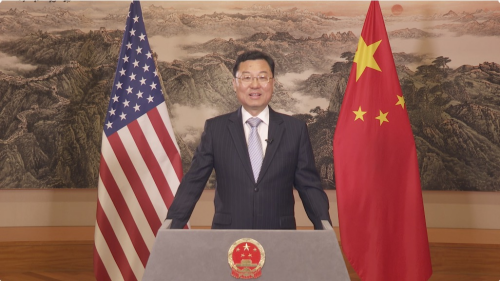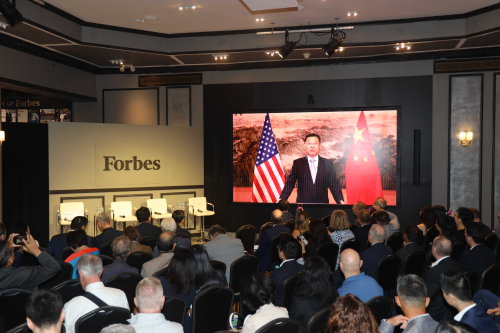
People’s Republic of China



August 27, 2024, New York
Distinguished guests,
Ladies and gentlemen,
Dear friends,
Good evening! It is a great pleasure to join you at the sixth U.S.-China Business Forum.
We are meeting at a challenging time. Globally, demand is sluggish. Inflation is high. Debts are mounting. Geopolitical conflicts keep flaring up. Economic globalization is under headwinds, and the world openness index is declining. All these have made the world economic outlook less certain. In such a complex world, searching for opportunities is a common endeavor, and expanding and deepening cooperation is the best way forward. I hope this forum will provide a platform for us all to tap into opportunities and boost cooperation.
Not long ago, the 20th Central Committee of the Communist Party of China held its third plenary session, which made systematic planning for further deepening reform comprehensively to advance Chinese modernization. A new milestone in China’s reform and opening-up, the meeting is also a gateway for the world to understand China. It will both shape China’s future trajectory, and influence the world in a significant way. The core message is: China’s journey of reform and opening-up will never stop. So what does this mean to the United States and the world? The answer is simple: opportunity, opportunity, and opportunity.
First, with reform in greater depth will come new opportunities for growth. Reform and opening-up have been crucial to enabling China to catch up with the times. It was through reform and opening-up that we accomplished our first centenary goal. To achieve the second centenary goal, this is the path we should continue along. The session rolled out over 300 reform measures, all of which should be completed by 2029. That is why some people call it “the most ambitious reform plan” in today’s world. For instance, we will deepen reform of state capital and SOEs, advance market-oriented reforms in sectors including energy, railway, telecom and water conservancy, formulate a private sector promotion law, and foster a fairer and more vibrant market environment.
In the first half of this year, China’s GDP grew 5% year-over-year, outperforming many other major economies. This shows its resilience. According to an IMF analysis, when China’s growth rate rises by 1 percentage point, growth in other economies will increase by around 0.3 percentage points. China will continue to be the top contributor to global growth over the next five years. We expect the Chinese economy, with its bigger size and stronger dynamism, will inject greater impetus into the world economy.
Second, with higher-standard opening-up will come new market opportunities. Opening-up is a defining feature of Chinese modernization. The session has made it clear that we will continue to promote reform through opening-up, and develop new institutions for a higher-standard open economy. We aim to make the pie bigger and the list of cooperation longer, so as to deliver win-win outcomes for all.
This means we will open up more doors. We will steadily expand institutional opening-up, align with high-standard international economic and trade rules, and harmonize rules, regulations, management, and standards in sectors such as property rights protection, industrial subsidies, government procurement and finance. After one year of trial, our pilot free trade zones in Shanghai, Beijing, Guangdong and others have already been fully aligned with international standards. We will, on our own initiative, open up wider in sectors including telecom, the internet, education, culture and medical services, and unilaterally expand opening-up to the least developed countries.
It also means we will break down more barriers. We will further shorten the negative list for foreign investment, lift all market access restrictions in manufacturing, and fully apply the negative list for cross-border trade in services. Last week, we released a guideline on further improving the market access system, which detailed measures including strengthening coordination of policies for domestic and foreign-funded enterprises, and removing market access barriers.
Third, with higher-quality development will come new opportunities for cooperation. High-quality development is our primary task in building China into a modern socialist country. The session called for fostering new quality productive forces in line with local conditions. This includes making traditional industries more digital, smarter and greener, developing new industries such as AI, aerospace and biomedicine, and also further integrating digital technology into the real economy.
Currently, China has 463,000 high-tech companies, and owns over 4 million valid domestic invention patents. In the Global Innovation Index, China ranks top among the middle-income economies. I guess some of you have noticed that the Chinese video game “Black Myth: Wukong” has recently become a global hit. Within just one hour of its launch, its concurrent player count hit 1 million, and its collaboration merch quickly sold out. So you can see the huge consumption potential in the debut economy, and also the magic of integrating traditional culture with modern technology.
Innovation is the hallmark of new quality productive forces, which needs an open ecosystem. We will continue to optimize market access for new industries and new forms of business, and make the Chinese market a magnet for global innovation, so as to unlock the vitality of our economy and also open up more room for cooperation with other countries.

Dear friends,
A major inspiration we can get from China-U.S. relations over the past 45 years is that when we work together, both countries and peoples will fare well; but when we turn against each other, both sides and the world will suffer. Cooperation is the only right choice. As the top two engines of world economic growth, China and the United States take up over one-third of the global economy, and about one-fifth of the global trade. Any decoupling between us would only make the world poorer. Over the past 45 years, our two-way trade expanded over 200 times, surpassing 600 billion US dollars annually. In the first seven months of this year, our two-way trade grew 4.1% when denominated in RMB. Therefore, we are already deeply intertwined and basically inseparable from each other.
In the face of the new circumstances and challenges, scapegoating solves no problem, and trade war, industrial war or tech war produces no winner. As the new round of scientific and technological revolution and industrial transformation is unfolding, all countries are on a boat sailing upstream. Only when we face the challenges squarely, make ourselves more competitive and paddle together can we ride the tide and forge ahead.
China and the United States should respect each other’s right to development, uphold reciprocity and mutual benefit, and find solutions through dialogue and consultation. We need to both expand cooperation in traditional areas including economy, trade and agriculture, and nurture cooperation in new areas such as climate change and AI, so that both our countries and the world will come out as winners.
The business community has always been an important participant and advocate of China-U.S. relations, a positive force in deepening mutually beneficial cooperation, and a valuable bridge for goodwill between our peoples. I am glad to see the lively interactions between the two sides over the past months. The USCBC Board visited China. The CCPIT Chairman led a delegation of Chinese entrepreneurs to the United States. The China-U.S. Economic and Trade Cooperation Forum was successfully held. All these have testified to our shared aspiration for more exchanges and cooperation.
Tesla’s Gigafactory Shanghai can now produce more than 950,000 vehicles per year, and its megapack factory there is nearly half complete just three months after construction started. Apple is ramping up its investment in China, expanding its applied research center in Shanghai and opening a new lab in Shenzhen. All these are evidence of the vigor of China-U.S. business cooperation.
When I was in California two weeks ago, I had some wonderful discussions with U.S. high-tech companies. They are so impressed by China’s world-class ecosystem for innovation, which cannot be replicated, and they believe the next China is still China. I encourage business leaders from both countries to seize the momentum and work hand in hand, make your rational voices better heard and forge closer ties while seeking greater success, so as to add more stability to China-U.S. relations with your concrete actions and fruitful cooperation.
Dear friends,
At the Paris Olympics, we saw how athletes from around the world acting on the Olympic spirit of “Faster, Higher, Stronger - Together”. They played by the rules, showed respect for each other, strove to be a better self and aimed for excellence. It was especially heartwarming when athletes from China and the United States shook hands and congratulated each other after an intense contest.
Likewise, there is simply no reason why the China-U.S. relationship should be a zero-sum game. Our two countries can well help each other succeed in a race to the top, and both develop ourselves and prosper together on this vast planet. President Xi Jinping outlined three principles for this relationship: mutual respect, peaceful coexistence and win-win cooperation. We are ready to work with the United States in that spirit, enhance dialogue and communication, properly manage differences, and expand mutually beneficial cooperation, so as to stabilize and improve the relationship and take it forward.
Thank you.


